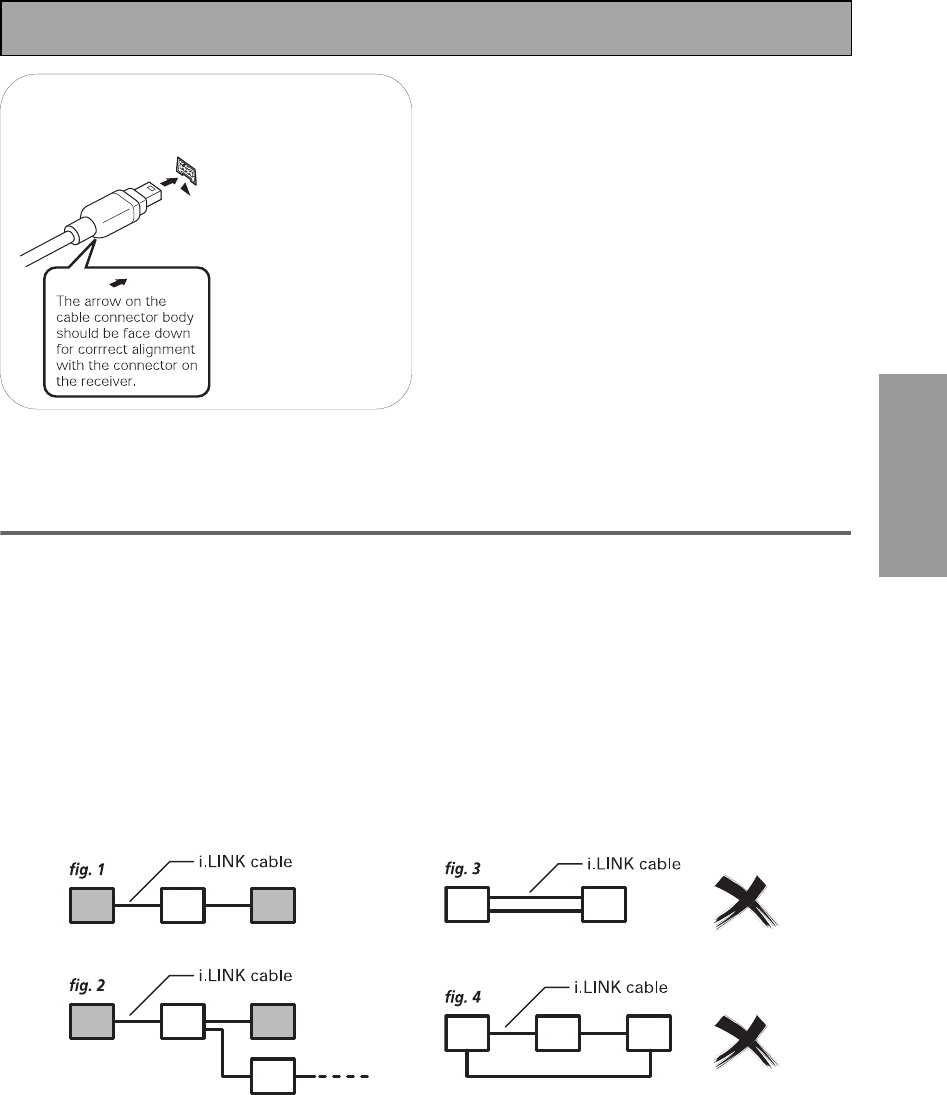
Using i.LINK Interface
29
En
PREPARATION
Memo:
• When properly connected, the i.LINK plug will snap
into the connector. If not connected properly the
receiver will not be able to recognize any connected
components.
• After connecting an i.LINK-equipped component to
the receiver, follow the instructions for both assigning
inputs on the receiver (see page 91) and output
settings on the component (see the manual that
came with the component).
• You can connect several i.LINK-equipped components
together in the same way. See Creating an i.LINK
Network below.
• There may be cases where the PQLS/ rate control
function and/or the i.LINK audio does not work
properly even when connected to an i.LINK-Audio-
compatible equipment.
• Do not connect/disconnect i.LINK cables or switch
on/off any components connected using i.LINK while
the receiver is on.
Creating an i.LINK Network
Using the i.LINK interface it is possible to chain up to 17 components together so that the digital audio and
control signals from each component is available to other components in the network. With the addition of an
i.LINK repeater, it’s possible to connect up to 63 components.
i.LINK connectors come in 4-pin and 6-pin configurations. This receiver uses a 4-pin connection, but the two
types can be mixed on a network.
This receiver is compatible with i.LINK Audio (also called “A & M Protocol”) components, such as DVD
players. It may not work properly if connected to i.LINK MPEG-II TS equipment (such as a digital satellite
tuner), i.LINK DV equipment (such as a DVD recorder or DV camcorder), or an i.LINK-equipped personal
computer. Check the operating instructions supplied with your other i.LINK components for capability
information.
Receivers need to be DTCP (Digital Transmission Content Protection) compliant to be able to play DVD-A,
DVD-Video, and SACD i.LINK audio. This receiver is DTCP compliant, so you can use them.
When setting up an i.LINK network, it’s important that the components form an open ended chain (fig. 1), or
a tree (fig. 2).
The system will not work if the connected components form a loop. If a loop is detected, the message LOOP
CONNECT shows in the display. Figs. 3 and 4 show connections that form a loop.
Another consideration when connecting i.LINK devices is the speed of the interface. At present there are
three speeds; S100 (slowest), S200 and S400 (fastest). This receiver uses the S400 type. Although you can use
components with different speeds together, we recommend connecting slower-speed components at the
edge of the network if possible (shown by the shaded boxes in figs. 1 and 2). This will keep the network free of
bottlenecks.
When used within an i.LINK network, this receiver must be on for the i.LINK connection to be maintained.
Other components in the network may or may not maintain the connection in standby (none will when the
power is completely off)—check the operating instructions supplied with individual components. Note that
the audio may be momentarily interrupted if a component in the i.LINK network is switched on/off, or its
i.LINK connection is switched on/off.
i.LINK connectors
Use a 4-pin, S400 i.LINK cable, less than 3.5 m long,
to connect i.LINK-equipped components.
Be sure to insert the
i.LINK cable straight
into connector. When
properly aligned the
cable can be inserted
with little resistance.
Forcing the cable into
the connector will
damage the connector
pins.
VSX-AX5i.book Page 29 Friday, May 23, 2003 6:33 PM


















